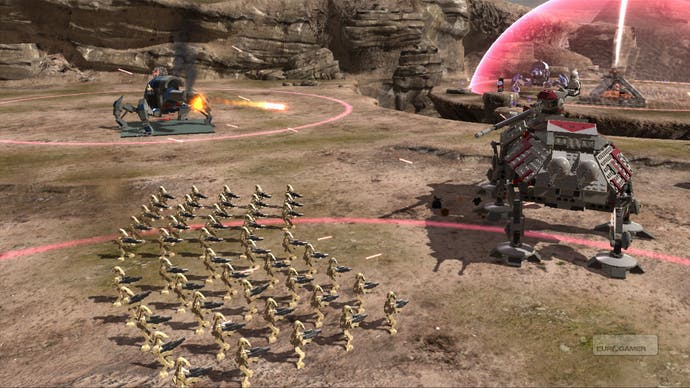LEGO Star Wars III: The Clone Wars
Not just another brick in the wall.
Elsewhere, scale and spectacle are on the menu. Swarms of enemies can now roam the screen, and there's genuine tactile pleasure to be taken in the way they scatter after being hit with a Force Push, a rocket blast or just a well-aimed step from a mechanical walker.
It's the ground battles that deviate furthest from what the majority of people will expect from a LEGO title, however.
These frequent diversions into large scale warfare set you down in an open plan battlefield. Dotted about are energy outlets around which bases can be built. The enemy almost always has a head start and has taken control of most of these vital objectives.
Your overall goal varies depending on the story, but success boils down to wresting control away from the Separatists by destroying all structures around each outlet and building something of your own.
The stud currency comes into play here, as everything you build has a price attached, and increasingly expensive options are unlocked the further you progress into the battle.
Giant cannons are a key early component, allowing you to bombard enemy positions from afar. Barracks will spawn platoons of Clone Troopers, air support towers can summon small infantry walkers or tanks, and further up the scale shields and arc energy weapons come into play.
At the same time your enemies are churning out their own forces, so the stage quickly becomes well populated - creating the sort of large scale engagements that were previously restricted to cut-scenes.

You're free to roam the battlefield, hopping into any vehicle you fancy or taking the helm of a cannon to take down a specific target. The explosions and smoke are something of a red herring. Your forces won't win the battle if left to their own devices, and nor do your enemies make any concerted attempt to capture your bases or retake control of one's they've lost.
The illusion of chaos is compelling, but it won't fool adult players. This is strategy gaming at its most immediate and lenient. It accommodates any mucking about that a youngster might attempt without penalty, but only allows forward progression when attacks are focused and directed by the player.
The downside is that battles can appear aimless. Without much in the way explanation as to what needs to be done or how to do it, kids may hit something of a brick wall here without a game-savvy parent on hand.
The laissez faire approach also brings both pros and cons to the over-arcing structure of the game. Your gameworld hub is the Resolute, Anakin Skywalker's command ship. Story missions are selected from a command deck console, and stages spread out along three winding paths from planet to planet.
Each storyline finds you on the trail of one or more Separatist villains and you're free to hop between plot threads as you go. The consoles also allow you to swap characters, play the two-player Jedi Arena mini-game and access the various bonus modes.
As in previous games, success in achieving the various goals of each level – complete the story, earn all the minikits, pick up enough studs – nets you a gold brick. The more gold bricks you have, the more of the hub world opens up as you're able to build more doorways to new sections of the ship.
It's the same sense of an unfurling gameworld that has been part of all the LEGO games, a constant state of discovery that feels like the best children's museum ever, where everything is interactive, everything does something and leads you on to somewhere else.
Clone Wars is, however, rather more opaque in its construction than its predecessors. There were several moments where I had absolutely no idea what I should do next to unlock more content.
The LEGO games excel at revealing their depths in tantalising layers, but this time it often feels like the goods are perhaps too well hidden. When dealing with younger gamers, especially those whose skills are still embryonic, a little more signposting would help keep the game flowing more smoothly.
Occasionally clunky structure aside, Clone Wars is still easy to recommend. There's ambition here that you wouldn't expect from a series on its eighth iteration. While stretching those boundaries has meant that the game loses some of its structural shape, the moment-by-moment experience is as enchanting and engaging as any previous entry.
Although this game is perhaps better suited to older children who grew up on the originals rather than youngsters taking their first gaming steps, the LEGO track record remains as solid as ever.

